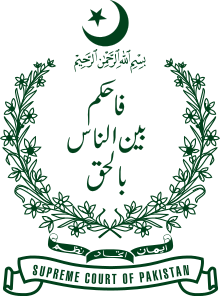Muhammad Munir
| Muhammad Munir | |
|---|---|
| Chief Justice of Pakistan | |
|
In office 29 June 1954 – 2 May 1960 | |
| Appointed by | Malik Ghulam Muhammad |
| Preceded by | Abdul Rashid |
| Succeeded by | Muhammad Shahabuddin |
| Personal details | |
| Born | 1895 |
| Died | 1979 (aged 83–84) |
| Alma mater | Government College University, Lahore |
Muhammad Munir (1895–1979) was the second Chief Justice of Pakistan serving from 1954 to 1960.
Background
Munir obtained his degree of master's in English Literature from Government College Lahore, he joined Law College to earn his L.L.B. He started his career as a lawyer in Amritsar in 1921. He moved to Lahore in 1922.[1]
Career
Munir was appointed assistant advocate-general of Punjab in 1937, and first president of the Income Tax Appellate Tribunal of India in 1940. He was elevated to the Bench of Judicature at Lahore in 1942. He and Justice Din Muhammad represented the All India Muslim League on the Punjab Boundary Commission in 1947. The following year he was made the chairman of the Pakistan Pay Commission. In 1949, he was made the chief justice of the Lahore High Court.[2]
Chief Justice
In 1954, Munir was made the chief justice of the Federal Court,[3] chief justice of Pakistan. Besides being the chief justice, he also remained the chairman of the Delimitation Commission from June 1956 to July 1958. He retired on May 2, 1960.[1]
Munir invoked the doctrine of necessity, validating the dissolution of the first Constituent Assembly of Pakistan. The assembly was dissolved on October 24, 1954, by Governor General Ghulam Muhammad, an alumnus of Aligarh Muslim University. He has been widely criticized for validating the dissolution, although some of the Pakistani politicians had called for its dissolution.[4]
Writings
Justice Munir also wrote a book From Jinnah to Zia, arguing that Jinnah stood for a secular state.[5][6][7][8]
See also
References
- 1 2 Chief Justice Muhammad Munir: his life, writings, and judgements. Research Society of Pakistan. 1973. Retrieved 16 May 2013.
- ↑ Chief Justice Muhammad Munir: His Life, Writings and Judgments. Research Society of Pakistan. 1973. Retrieved 16 May 2013.
- ↑ Paula R. Newberg (16 May 2002). Judging the State: Courts and Constitutional Politics in Pakistan. Cambridge University Press. pp. 25–. ISBN 978-0-521-89440-1. Retrieved 16 May 2013.
- ↑ Imtiaz Omar (2002). Emergency powers and the courts in India and Pakistan. Martinus Nijhoff Publishers. pp. 55–. ISBN 978-90-411-1775-5. Retrieved 16 May 2013.
- ↑ Muhammad Munir (1980). From Jinnah to Zia. Vanguard Books. Retrieved 16 May 2013.
- ↑ Muhammad Munir. Goodreads Mobile | see what your friends are reading. Goodreads.com. Retrieved 2013-05-16.
- ↑ "From Jinnah to Zia". Thenews.com.pk. Retrieved 2013-05-16.
- ↑ Hafiz Sher Muhammad. The Ahmadiyya Case. www.aaiil.org. pp. 316–. GGKEY:19TKD2GN31G. Retrieved 16 May 2013.
| Legal offices | ||
|---|---|---|
| Preceded by Abdul Rashid |
Chief Justice of Pakistan 1954–1960 |
Succeeded by Muhammad Shahabuddin |
